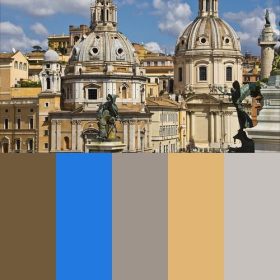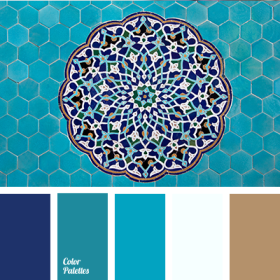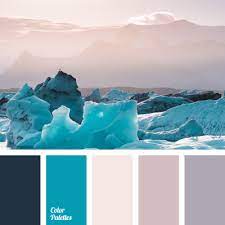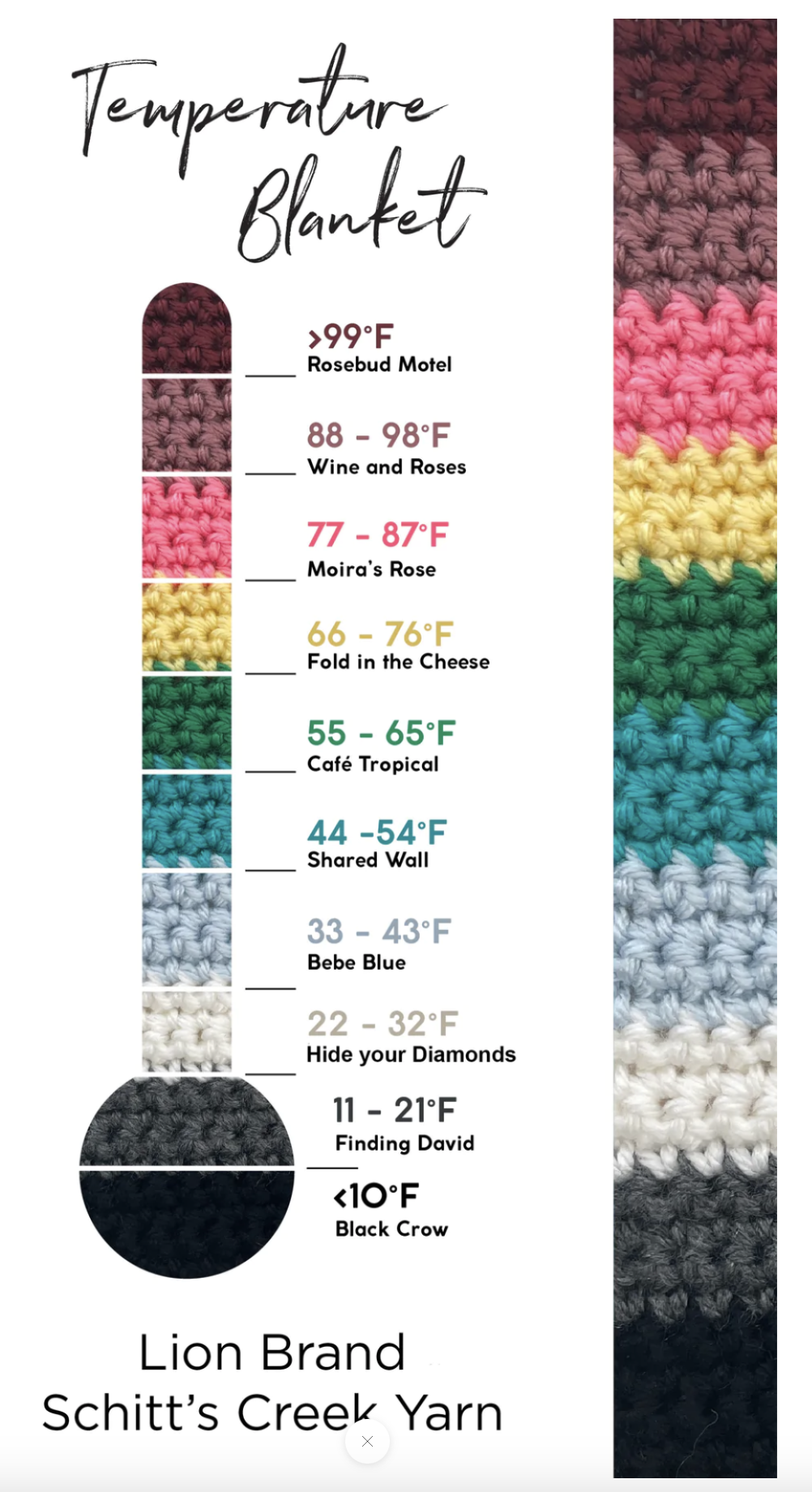Blog, Color theory, Crochet, Knit
Top Tips for Making a Knit or Crochet Temperature Blanket or Afghan
You’re probably familiar with the popular knit or crochet temperature blanket (or afghan) patterns which have been popular over the last several years. If not, I am happy to explain them to you: they are a physical record of the temperature during a fixed period of time using predetermined temperature ranges depicted by specific yarn colors in a knitting or crochet project.
A Temperature Blanket: a physical record of the temperature during a fixed period of time using predetermined temperature ranges depicted by specific yarn colors.
When you are making a knit or crochet Temperature Blanket, you can decide the stitch pattern, the number of colors of yarn, the color palette, the period of time you want to represent, and the temperature range for each color.
Download my FREE Temperature Blanket Free Worksheets! You can print them out or fill out the forms digitally right inside the PDF file!
Temperature Blanket Free Worksheets Download Printable and Fillable
There are many sentimental reasons for making a knit or crochet temperature blanket: the birth year of a loved one, the current year for a baby shower or wedding, or the mysterious anticipation of making it in real time with current, local weather. Perhaps you’d like to immortalize your favorite vacation or dream vacation destination or represent your family’s heritage.
As an example, let’s say you want your temperature blanket to represent the year 1985 in Rome, Italy. You can be inspired by any period of time, any time frame, and any location on earth! What if you want to represent your favorite vacation spot, your hometown, or a dream vacation spot you hope to visit one day? With the help several websites including wunderground, the weather network, climate.gov, or weatherspark.com, you can find the historical temperature information by day for any place on earth in any period of recorded time.
I’m using Fahrenheit temperature scale but you can use Celsius, too. Both sets of data are available.
I recorded a monthly range of data to get a better understanding on the range of temperature throughout the year. You will need each day’s temperature for the blanket, but first we need to figure out the number of colors of yarn and range of temperature representation of each color in our palette.
Rome, Italy in 1985 has a monthly temperature range from:
- January 48 to 59 degrees
- February 54 to 64 degrees
- March 50 to 64 degrees
- April 55 to 73 degrees
- May 68 to 90 degrees
- June 68 to 91 degrees
- July 82 to 99 degrees
- August 81 to 97 degrees
- September 63 to 91 degrees
- October 55 to 75 degrees
- November 54 to 70 degrees
- December 48 to 63 degrees
From this data, I can see that the year’s temperature range is 48 to 99 degrees. 99 – 48 = 51 temperatures to represent in our blanket. If I wanted to do my blanket in 5 colors, that would be 51/5 = 10.2 or roughly 10 temperatures represented per color. You can either round up your quantity of colors or temperature range to get whole numbers. I chose to round up the temperature range on the last color to maintain 5 colors in this palette.
For example in 5 colors:
- Temperature in range 48 – 58 color A
- Temperature in range 59 – 68 color B
- Temperature in range 69 – 78 color C
- Temperatures in range 79 – 88 color D
- Temperatures in range 89 – 99 color E
For example in 10 colors of yarn, you would divide the temperature range (51) by 10: 51/10 = 5.1 or roughly 5 temperature degrees represented per color. You could either round up your quantity of colors or temperature range to get whole numbers. I chose to round the colors of yarn up to 11 to maintain 5 degree temperature range per color
For example in 11 colors:
Temperatures in range 48 – 52 color A
Temperatures in range 53 – 57 color B
Temperatures in range 58 – 62 color C
Temperatures in range 63 – 67 color D
Temperatures in range 68 – 72 color E
Temperatures in range 73 – 77 color F
Temperatures in range 78 – 82 color G
Temperatures in range 83 – 87 color H
Temperatures in range 88 – 92 color I
Temperatures in range 93 – 97 color J
Temperatures in range 98 – 99 color K
How to Choose the Color Palette for your Knit or Crochet Temperature Blanket:
 Choosing colors is such a personal experience but can also be overwhelming and intimidating if you are unsure of which colors go together. In the words of Picasso, “Learn the rules like a pro, so you can break them like an artist.”
Choosing colors is such a personal experience but can also be overwhelming and intimidating if you are unsure of which colors go together. In the words of Picasso, “Learn the rules like a pro, so you can break them like an artist.”
A color wheel is a great tool to use when choosing colors for any project. I like this color wheel and use mine often!
Picking cool and warm toned colors to represent the temperature of your afghan is a very common way to choose colors for a temperature blanket. White, shades of blue, green and gray for the colder temperature ranges, and yellows, oranges, reds and purples for the warmer temperature ranges. But you can also represent any color story you desire in your palette. Maybe it is choosing your gift recipients favorite colors. Let’s say you are making it for your mom and she loves pinks and purples. You could find a yarn with a great range of shade in the pink and purple family of colors. Keep in mind, the larger the palette, the more variation in your color palette. So within shades of pink and purple, you might want to look at magentas (the redder side of violet) and periwinkles (the bluer side of violet), too.
Analogous colors is another great way to choose colors for a temperature blanket. Analogous means colors that are very similar to each other, especially when they are next to each other on a color wheel. For example: red, red-orange, orange-red and orange are analogous colors. So are violet, violet-blue, blue-violet and blue. these can make striking palettes and you can also use a pop of a natural to break it up if you want: white, tan, taupe, gray, or black.
Using Mother Nature is a wonderful way to combine colors in a palette, too. A flower garden has a variety of flower colors and leave and step colors that all work beautifully together.
You can also take a photo of the location you are representing in your temperature blanket as inspiration for your palette, too. For example, here are some palette ideas for different locations in Rome, Italy:
These images are for inspiration! Loosely use these combinations as your guide since you will still have to find yarns that work for your budget, your gauge and your color palette, too.
And here are some color inspiration photos from other parts of the world, too:
Choose the type of knit or crochet stitches you want for your temperature blanket.
Next you will want to decide what kind of stitches you want to use. In crochet, I think shorter stitches like single crochet, extended single crochet, seed stitch or Tunisian simple stitch or will give you the range for creating 365 rows. And in knitting, I think simpler stitches will allow the color sequence to shine, like garter stitch, stockinette stitch or seed stitch.
Learn How to Knit and Crochet Here:
Decide on the gauge for your temperature blanket.
Here are a few blanket sizes with a few gauge measurements to get you started.
Knit or Crochet Temperature Blanket Pattern Guide:
At 3 sts / 4 rows per inch
36 in square baby blanket
36 (3) = 108 sts
36 (4) = 144 rows
50 in x 60 in medium afghan
50 (3) = 150 sts
60 (4) = 240 rows
70 x 80 large afghan
70 (3) = 210 sts
80 (4) = 320 rows
At 4 sts / 5 rows per inch
36 in square baby blanket
36 (4) = 144 sts
36 (5) = 10 rows
50 in x 60 in medium afghan
50 (4) = 200 sts
60 (5) = 300 rows
70 x 80 in large afghan
70 (4) = 280 sts
80 (5) = 400 rows
At 5 sts / 6 rows per inch
36 in square baby blanket
36 (5) = 180 sts
36 (6) = 216 rows
50 in x 60 in medium afghan
50 (5) = 250 sts
60 (6) = 360 rows
70 in x 80 in large afghan
70 (5) = 350 sts
70 (6) = 420 rows
As you can see, playing with your gauge and blanket size can get you closer or farther away from having 365 rows. to do temperature blanket that represents a full year’s worth of temperature data. But don’t let that stop you! If you heart is set on a particular gauge or blanket size, simply alter the amount of temperature data you wish to represent in your temperature blanket.
But why limit yourself to just making a temperature blanket in just simple stitches and rows?
- You could make small motifs and let each one represent a day, a week or a month. Or you could make larger motifs and allow each round to represent a day. Maybe a 7 round motif represents a week then you make 52 of them to join together.
- You could make knit or crochet strips. And each strip could represent a week or a month. Then each section within the strip could represent a smaller period of time. For example, if you make 12 strips (representing each month) you could make 30 stripes to represent each day in that month. Or you could make 52 strips to represent the weeks of the year and make 7 stripes in each strip to represent each day of that week.
- You could work corner to corner or work on the bias for diagonal stripes.
- You could work a square or rectangle in the round and represent each round as a day, week or month. Based on your gauge, maybe you work a certain number of stitches to represent each day of the year and continue to make a growing square or rectangle for the entire year.
- So many possibilities, so little time!
Choose the yarn for your temperature blanket.
Here is a handy guide for yardage estimates for various projects, including blankets, over several yarn weights:
Here is a fun kit put together for you already by Lion Brand Yarn along with an invitation to join their 2023 Knit and Crochet Along for Temperature Blankets:
Crochet Temperature Blanket Pattern
from Annie’s Catalog
Knit Temperature Scarf Pattern
from Annie’s Catalog
































